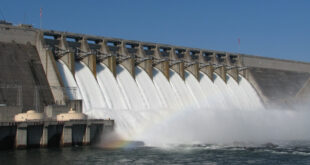The global water market is projected to reach a total value of $914.9 billion in 2023. according to the latest 2018-2023 forecasts published by Global Water Intelligence (GWI). GWI’s market research linked this growth to a recovering global economy. high commodity and oil prices. and major water quality and infrastructure plans such as those in Saudi Arabia. China. and Southeast Asia aimed at improving wastewater treatment and incentivizing private finance in water. The forecasts are available to GWI WaterData subscribers and were published as part of a major update to the WaterData platform.
New forecasts published by GWI have projected that the value of the global water market. representing the sum of both operating and capital expenditures by utilities and industrial water users on water and wastewater. is expected to grow from $770 billion in 2018 to $914.9 billion by 2023.
Christopher Gasson. Publisher at GWI. said “the global water market is growing at a faster rate than at any time since 2010. driven by a buoyant global economy and a recovery in the oil price. That said. the rate of investment is still well below what is needed to maintain existing infrastructure and keep up with the demands of urbanization. environmental protection and climate change.“
GWI’s team of research analysts found that the projected increase in global capital expenditure on water and wastewater is being fueled by a return to growth for key industry sectors such as mining. upstream oil &. gas. and microelectronics. Commodity and oil prices experienced a rebound in 2017 off the back of successfully implemented OPEC production cuts and a growing global demand for commodities such as copper. lithium. and nickel as a result of increased demand for batteries and electric vehicles.
GWI’s analysts have forecast increases in spending on water and wastewater treatment systems. particularly in the oil &. gas and mining sectors. over the next five years.
The market for oil-water separation technologies for instance. is forecast to grow by 14.6% bringing new opportunities for technology suppliers and specialists in water management and treatment. Rising oil prices are facilitating a boom in the North American fracking industry. and the renewed exploitation of mature fields like the Permian Basin which increasingly have high water management and treatment requirements. GWI found that the average number of water barrels used per frack in the Permian Basin increased 434% between 2013 – 2016.
The North American fracking boom is also creating a new market for “midstream“ water management infrastructure where water is piped. managed and treated at plants in closer proximity to the fields. in order to more easily meet the water needs of the fracking industry.
Similarly. GWI’s analysts forecast that global capital expenditure on water and wastewater by the mining industry will increase by 23.5% to $1.64 billion by 2019. mirroring a sustained increase in the price of commodities such as copper. nickel. cobalt. and chromium worldwide. fueling the expansion of mining operations as well as new projects.
The new forecast updates suggest the growth of the mining industry. coupled with increasing competition for water resources between municipalities and industries in regions threatened with water scarcity. will create new opportunities for seawater desalination and water reuse projects. as the world’s mining hubs act to secure their water needs.
Chile for example. is set to become a key source of desalination project opportunities. A 128.5% increase in the use of seawater in the country’s mining operations is expected over the next ten years. driven by continued investments in new mining projects. and the impact of a new regulation which makes desalination mandatory for mining operations with water needs exceeding 12.960m3 d.
GWI’s market analysis also found the introduction of more stringent water and wastewater quality regulations will have a significant impact on the dynamics and growth prospects of several key water markets over the next five years. especially in China and India.
Increased regulatory powers of relevant agencies in both countries has resulted in stricter enforcement. and a clear uptick in project flow for wastewater treatment projects. In China. drives to tackle flooding and stormwater pollution under the ‘sponge city’ program and to centralize and standardize industrial park wastewater treatment are coinciding. creating a diverse range of technology opportunities. India meanwhile is seeing a breakthrough in the adoption of reuse technologies. due to government directives demanding the use of treated sewage effluent in the power industry.
GWI also expects a major uptick in reuse projects to occur in China. as the central government tightens water pollution regulations for both utilities and industry. The 13th Five-Year Plan calls for 90% of municipal sludge to be treated to new. tougher environmental standards by 2020. creating new opportunities for projects and technologies focused on sludge management in one of the world’s largest water markets.
Additionally. the forecast updates suggest that the international water market is experiencing the strongest pro-privatization wave in two decades. following on from the major national water privatization program announced in Saudi Arabia in 2018.
GWI’s analysts highlighted the expansion of private finance models for water in Southeast Asia as a key part of this pro-privatization trend. The string of IPOs carried out by Vietnam’s utilities to raise the capital to expand wastewater treatment networks. the use of private finance for water beyond Metro Manila in the Philippines. and Indonesia’s progressing national PPP plans all look to provide opportunities for international investors and companies working in wastewater.
 Iran Energy News Oil, Gas, Petrochemical and Energy Field Specialized Channel
Iran Energy News Oil, Gas, Petrochemical and Energy Field Specialized Channel




